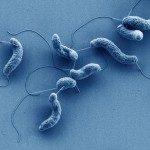Link to Pubmed [PMID] – 30566629
Link to DOI – 10.1093/nar/gky1258
Nucleic Acids Res 2019 Feb; 47(4): 1861-1870
A predominant tool for adaptation in Gram-negative bacteria is the functional genetic platform called integron. Integrons capture and rearrange promoterless gene cassettes in a unique recombination process involving the recognition of folded single-stranded DNA hairpins-so-called attC sites-with a strong preference for the attC bottom strand. While structural elements have been identified to promote this preference, their mechanistic action remains incomplete. Here, we used high-resolution single-molecule optical tweezers (OT) to characterize secondary structures formed by the attC bottom (${{att}}{{{C}}_{{\rm{bs}}}}$) and top (${{att}}{{{C}}_{{\rm{ts}}}}$) strands of the paradigmatic attCaadA7 site. We found for both sequences two structures-a straight, canonical hairpin and a kinked hairpin. Remarkably, the recombination-preferred ${{att}}{{{C}}_{{\rm{bs}}}}$ predominantly formed the straight hairpin, while the ${{att}}{{{C}}_{{\rm{ts}}}}$ preferentially adopted the kinked structure, which exposes only one complete recombinase binding box. By a mutational analysis, we identified three bases in the unpaired central spacer, which could invert the preferred conformations and increase the recombination frequency of the ${{att}}{{{C}}_{{\rm{ts}}}}$in vivo. A bioinformatics screen revealed structural bias toward a straight, canonical hairpin conformation in the bottom strand of many antibiotic resistance cassettes attC sites. Thus, we anticipate that structural fine tuning could be a mechanism in many biologically active DNA hairpins.


